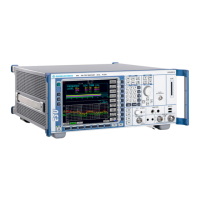R&S ESU Instrument Functions
Analyzer Mode
4.126 Operating Manual 1302.6163.12 - 03
The length of the gate signal defines when the sweep is to be interrupted. Here a dif-
ferentiation is made between edge-triggered and level-triggered modes: in case of
edge triggering the gate length can be set via the GATE LENGTH softkey, while in
case of level triggering the gate length depends on the length of the gate signal.
Fig. 4.5 Timing diagram for GATE, GATE DELAY and GATE LENGTH
This softkey requires the EXTERN or IF POWER trigger mode. If a different mode is
active, IF POWER is automatically selected.
Gated-sweep operation is also possible in the time domain. This enables - e.g. in
burst signals - level variations of individual slots to be displayed versus time.
To indicate that a gate is used for the sweep, the enhancement label GAT is dis-
played on the screen. This label appears to the right of the window for which the
gate is configured.
Remote command: SWE:EGAT ON
SWE:EGAT:SOUR IFP
or:
SWE:EGAT:SOUR EXT
GATE
SETTINGS
The GATE SETTINGS softkey calls a submenu for making all the settings required
for gated-sweep operation.
At the same time, a transition is made to the time domain (span = 0) and the time
parameters GATE DELAY and GATE LENGTH are represented as vertical lines.
This allows the required gate time parameters to be set easily.
For highly accurate setting of gate delay and gate length, the x-axis can be altered
using the SWEEPTIME softkey in a way that the signal range concerned (e.g. one
full burst) is displayed.
Then the sampling time and duration can be set by GATE DELAY and GATE
LENGTH in a way that the desired portion of the signal is shown.
RF
Ext. Gate
Meas. active
Gate Mode LEVEL Gate Mode EDGE
Delay
Length
Delay
GATE MODE LEVEL | EDGE
POLARITY POS | NEG
GATE DELAY
GATE LENGTH
SWEEPTIME

